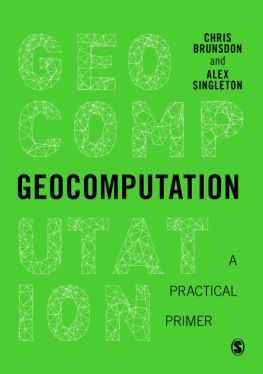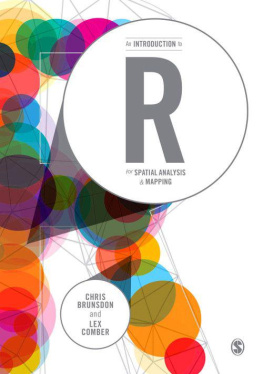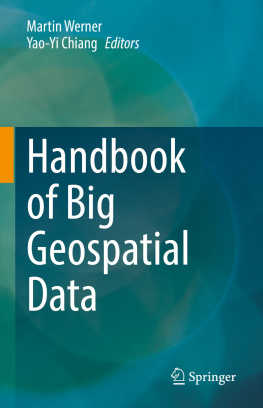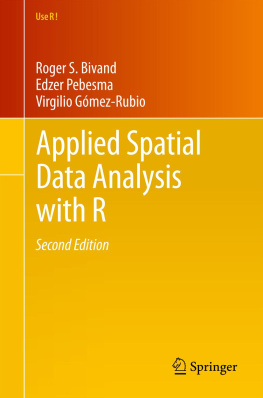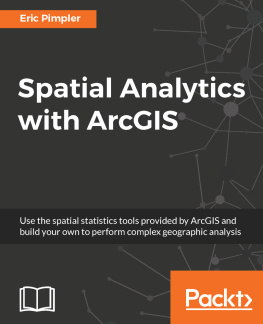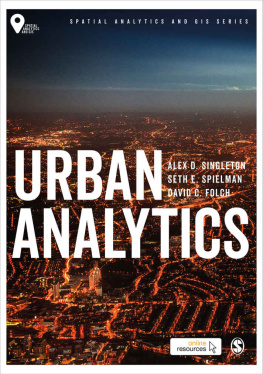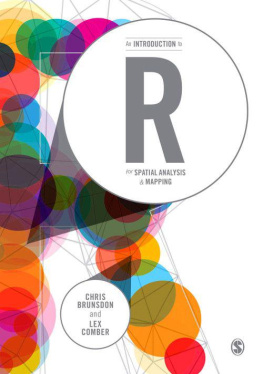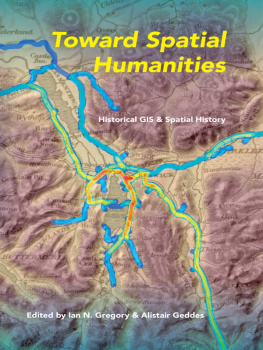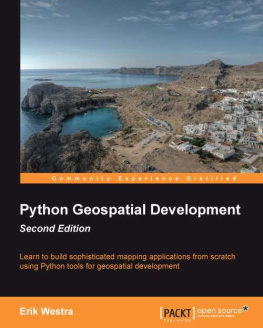
For Melissa, Erin, Theo and Max

Chris Brunsdon and Alex Singleton 2015
James Cheshire and Robin Lovelace 2015
Paul M. Torrens 2015
Michael Batty 2015
Andrew Crooks 2015
Mark Birkin 2015
Harvey J. Miller 2015
David Rohde and Jonathan Corcoran 2015
Alexandros Alexiou and Alex Singleton 2015
Seth Spielman and David C. Folch 2015
Daniel Lewis 2015
Melanie Tomintz, Graham Clarke and Nawaf Alfadhli 2015
Tomoki Nakaya 2015
Karyn Morrissey 2015
Sergio J. Rey 2015
Chris Brunsdon and Lex Comber 2015
Oliver OBrien 2015
Richard Kingston 2015
First published 2015
Apart from any fair dealing for the purposes of research or private study, or criticism or review, as permitted under the Copyright, Designs and Patents Act, 1988, this publication may be reproduced, stored or transmitted in any form, or by any means, only with the prior permission in writing of the publishers, or in the case of reprographic reproduction, in accordance with the terms of licences issued by the Copyright Licensing Agency. Enquiries concerning reproduction outside those terms should be sent to the publishers.
Library of Congress Control Number: 2014940792
British Library Cataloguing in Publication data
A catalogue record for this book is available from the British Library
ISBN 978-1-4462-7292-3
ISBN 978-1-4462-7293-0 (pbk)

SAGE Publications Ltd
1 Olivers Yard
55 City Road
London EC1Y 1SP
SAGE Publications Inc.
2455 Teller Road
Thousand Oaks, California 91320
SAGE Publications India Pvt Ltd
B 1/I 1 Mohan Cooperative Industrial Area
Mathura Road
New Delhi 110 044
SAGE Publications Asia-Pacific Pte Ltd
3 Church Street
#10-04 Samsung Hub
Singapore 049483
Editor: Robert Rojek
Assistant editors: Keri Dickens and Matt Oldfield
Production editor: Katherine Haw
Copyeditor: Richard Leigh
Proofreader: Neil Dowden
Marketing manager: Michael Ainsley
Cover design: Francis Kenney
Typeset by: C&M Digitals (P) Ltd, Chennai, India
Printed and bound by Ashford Colour Press Ltd

At SAGE we take sustainability seriously. Most of our products are printed in the UK using FSC papers and boards. When we print overseas we ensure sustainable papers are used as measured by the Egmont grading system. We undertake an annual audit to monitor our sustainability.
CONTENTS
Chris Brunsdon and Alex Singleton
James Cheshire and Robin Lovelace
Paul M. Torrens
Michael Batty
Andrew Crooks
Kirk Harland and Mark Birkin
Harvey J. Miller
David Rohde and Jonathan Corcoran
Alexandros Alexiou and Alex Singleton
Seth Spielman and David C. Folch
Daniel Lewis
Melanie Tomintz, Graham Clarke and Nawaf Alfadhli
Tomoki Nakaya
Karyn Morrissey
Sergio J. Rey
Chris Brunsdon and Alex Singleton
Chris Brunsdon and Lex Comber
Oliver OBrien
Richard Kingston
Chris Brunsdon and Alex Singleton
ABOUT THE AUTHORS
Alexandros Alexiou holds a degree in Spatial Planning and Survey Engineering from the University of Thessaly, as well as an MSc in Transport Planning from the Aristotle University of Thessaloniki and an MPhil in Planning from the University of Cambridge. Alexandros is currently a PhD candidate at the University of Liverpool, with research interests in the creation of new models of urban socio-spatial structure that better account for both geographic context and the dynamics of population.
Nawaf Alfadhli is a PhD candidate at the School of Geography, University of Leeds. His PhD is on the subject of the deployment of GIS techniques within the crime field in the local authority of Kuwait. By using a mixture of location-allocation and spatial interaction models Nawaf is building a decision support system for use by local planners in Kuwait to help them monitor, analyse and prevent criminal activity through the better deployment of resources over space and time.
Michael Batty is Professor of Urban Planning at University College London where he is Chair of the Centre for Advanced Spatial Analysis (CASA). His research and the work of his centre is focused on computer models of city systems. In recent years he has been awarded the William Alonso Prize of the Regional Science Association, the University Consortium GIS Research Award and the Laurat Prix International de Gographie Vautrin Lud. His research has focused on the development of analytical methods and computer models for simulating the structure of cities and regions. His work began with aggregate land use transport models, and he then moved into more visual representations of cities and their models, more recently focusing on complexity theory as reflected in his blogs www.complexcity.info and www.spatialcomplexity.info .
Mark Birkin is Professor of Spatial Analysis and Policy in the School of Geography at the University of Leeds. His major interests are in simulating social and demographic change within cities and regions, and in understanding the impact of these changes on the need for services such as housing, roads and hospitals, using techniques of microsimulation, agent-based modelling and GIS. He is currently the project leader for TALISMAN the spatial data analysis and simulation node of the ESRCs National Centre for Research Methods.
Chris Brunsdon is Professor of Geocomputation and Director of the National Centre for Geocomputation at the National University of Ireland, Maynooth. He obtained his BSc at the University of Durham and his MSc and PhD at the University of Newcastle upon Tyne. He has been involved in a number of spatial analysis and GIS projects in the UK. His research interests include: reproducible research; exploratory spatial data analysis and visualisation; spatial statistics; Bayesian approaches; health data analysis and the analysis of crime patterns. He is on the editorial boards of a number of journals and has sat on a number of assessment panels for research funding institutions.
James Cheshire completed a BSc in Physical Geography at the University of Southampton before undertaking his PhD in Geographical Information Science at the Department of Geography of University College London (UCL). His topic concerned the spatial analysis and visualisation of large surname databases. Since completing his PhD he has been a Lecturer in Advanced Spatial Analysis and Visualisation at CASA and is now a Lecturer in Quantitative Human Geography at UCL. Aside from his academic outputs, a wide range of his maps and visualisations have been featured in the popular print press (such as the National Geographic and the Guardian) as well as online. He enjoys blogging both for spatial.ly and mappinglondon.co.uk.
Graham Clarke is Professor of Business Geography at the University of Leeds. He has worked extensively in various areas of GIS and applied spatial modelling, focusing on many applications within urban/social geography. A major research interest has been spatial microsimulation, a technique for estimating missing data and producing detailed household datasets for use in a wealth of social science simulations (especially income, wealth, crime and health applications). Graham has also been very active in retail geography and retail store location research. A major contribution to research in retail location planning has been to rethink the research agenda on store location in relation to the multi-channel growth strategies of retail organisations. An important additional research stream has been work on retail provision, saturation and internationalisation.
Next page
